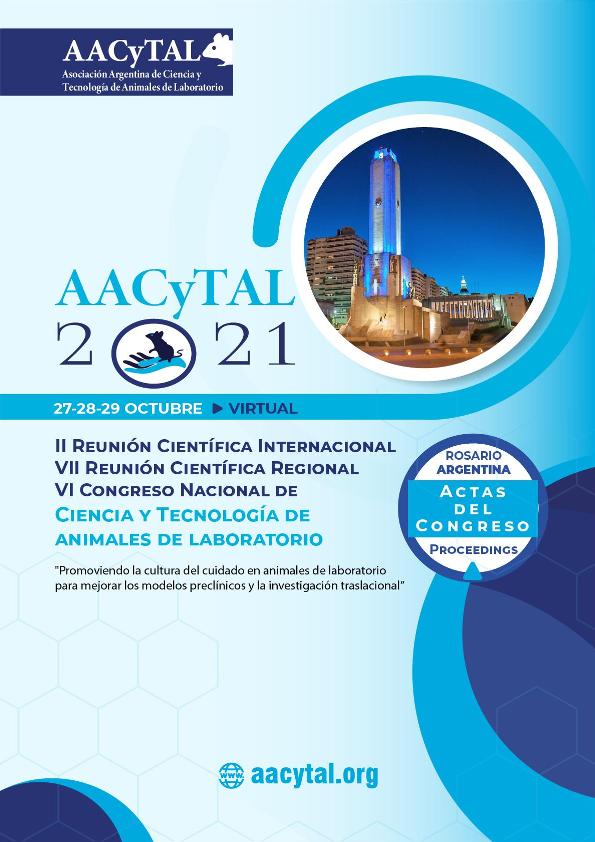Evento
How to improve the survival of female cf-1 mice during the infection via the portal vein with Echinococcus granulosus protoscoleces?
Scioscia, Nathalia Paula ; Pensel, Patricia Eugenia
; Pensel, Patricia Eugenia ; Albani, Clara Maria
; Albani, Clara Maria ; Fabbri, Julia
; Fabbri, Julia ; Denegri, Guillermo Maria
; Denegri, Guillermo Maria ; Elissondo, María Celina
; Elissondo, María Celina
 ; Pensel, Patricia Eugenia
; Pensel, Patricia Eugenia ; Albani, Clara Maria
; Albani, Clara Maria ; Fabbri, Julia
; Fabbri, Julia ; Denegri, Guillermo Maria
; Denegri, Guillermo Maria ; Elissondo, María Celina
; Elissondo, María Celina
Tipo del evento:
Reunión
Nombre del evento:
II Reunión Científica Internacional, VII Reunión Científica Regional y VI Congreso Nacional de Ciencia y Tecnología de Animales de Laboratorio
Fecha del evento:
27/10/2021
Institución Organizadora:
Asociación Argentina de Ciencia y Tecnología de Animales de Laboratorio;
Título del Libro:
II Reunión Científica Internacional, VII Reunión Científica Regional y VI Congreso Nacional de Ciencia y Tecnología de Animales de Laboratorio: Actas del Congreso
Editorial:
Asociación Argentina de Ciencia y Tecnología de Animales de Laboratorio
ISBN:
978-987-47524-0-6
Idioma:
Inglés
Clasificación temática:
Resumen
Portal vein injection is a technique used for the development of different murine models of pathologies and parasitic diseases in the liver. These procedures require laparotomy and must be performed under anesthesia and analgesia to prevent discomfort, pain and /or distress. In order to optimize the survival rate of animals, the purpose of this study was to evaluate an injectable anesthesia protocol for the development of a murine model of hepatic cystic echinococcosis in female CF-1 mice. Animal procedures and management protocols were approved by the Institutional Animal Care and Use Committee of the Faculty of Exact and Natural Sciences, National University of Mar del Plata (RDs 468/17 and 211/2018). Forty three mice (Mus musculus; 6-7 weeks of age, body weight 26 ± 2 g) were allocated into six groups: 1) ketamine/xylazine 100/10 mg/kg; 2) pre-anesthetic drugs + ketamine/xylazine 100/10 mg/kg; 3) pre-anesthetic drugs + ketamine/xylazine 100/10 mg/kg + yohimbine; 4) ketamine/xylazine 80/8 mg/kg; 5) pre-anesthetic drugs + ketamine/xylazine 80/8 mg/kg; and 6) pre-anesthetic drugs + ketamine/xylazine 80/8 mg/kg + yohimbine. Atropine sulfate (0.4 mg/kg, subcutaneously) and tramadol hydrochloride [2 mg/kg, via intraperitoneal (IP)] were administered as pre-anesthetic drugs. The anesthetic cocktail (ketamine/xylazine) was applied IP and after confirming the loss of reflexes of mice, portal vein infection with Echinococcus granulosus protoscoleces was carried out. Yohimbine (a reverser of xylazine, 0.5 mg/kg) was injected IP immediately at the end of the suture. All groups achieve a deep surgical anesthetic plane and profound analgesia, except mice treated only with ketamine/xylazine at the doses of 80/8 mg/kg. Pre-anesthetic drugs application significantly reduced time induction of animals compared with those that received only the anesthetic cocktail (P < 0.05). The mice that underwent laparotomy and received yohimbine after surgery had a survival rate of 100 %. Moreover, treatment with yohimbine significantly reduced the recovery time of mice treated with pre-anesthetic drugs and ketamine/xylazine 80/8 mg/kg. In addition, we found differences between the response to the doses of ketamine/xylazine in animals treated with pre-anesthetic drugs and yohimbine. The recovery time of mice treated with ketamine/xylazine 80/8 mg/kg was significantly faster than that observed under doses of 100/10 mg/kg, respectively (P < 0.01). Therefore, the duration of action was significantly shorter when the applied doses of ketamine/xylazine were 80 and 8 mg/kg. We recommend the protocol that applied pre-anesthetic drugs + ketamine/xylazine 80/8 mg/kg + yohimbine as safe and reliable for the portal vein infection of mice with protoscoleces of E. granulosus.
Palabras clave:
Echinococcus granulosus
,
Portal vein
Archivos asociados
Licencia
Identificadores
Colecciones
Eventos (IIPROSAM)
Eventos de INSTITUTO DE INVESTIGACIONES EN PRODUCCION, SANIDAD Y AMBIENTE
Eventos de INSTITUTO DE INVESTIGACIONES EN PRODUCCION, SANIDAD Y AMBIENTE
Citación
How to improve the survival of female cf-1 mice during the infection via the portal vein with Echinococcus granulosus protoscoleces?; II Reunión Científica Internacional, VII Reunión Científica Regional y VI Congreso Nacional de Ciencia y Tecnología de Animales de Laboratorio; Argentina; 2021; 66-67
Compartir



